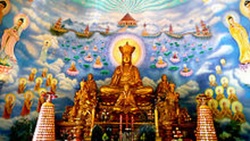The Chinese Buddhist Schools: Pure Land
All forms of Chinese Buddhism, including Chan, contain devotional elements and rituals, but for Pure Land Buddhists devotionalism is the essence. The origins of Pure Land Buddhism are somewhat unclear. While undoubtedly devotional practices were imported to China by monks and laity (and these were blended with native Chinese forms of devotionalism), there does not seem to be a distinct school in India devoted to rebirth in Amitābha’s Pure Land. As noted earlier, the traditional lineages are not very helpful for reconstructing the school’s history. According to tradition, early contributors to Pure Land thought and practice include Tanluan (476–542), Dao Chuo (562–645) and his student Shandao (613–81). The term ‘Pure Land’ (jingtu) may itself be largely a product of certain license taken by translators. The term jingtu appears in Kumārajīva’s translation of the Vimalakīrti Sutra where the Tibetan version simply has ‘Buddha lands’ (the Sanskrit version is no longer extant). Apparently, Xuanzang was the first explicitly to associate Sukhāvati (Amitābha’s Paradise) with the term ‘pure land’. The main scriptures for Pure Land practice were the Larger and Smaller Sukhāvati-vyuha Sutras and the Guan Wuliangshuofo jing.
At the beginning of the Tang Dynasty, several forms of Buddhist devotionalism were popular, including cults devoted to Mañjuśrī(Bodhisattva of Wisdom), Guanyin (Bodhisattva of Compassion, at that time particularly popular as a patron saint and protector of travellers), Maitreya (the future Buddha) and Amita (a conflation of Amitābha and Amitāyus whose names mean ‘Infinite Light’ and ‘Infinite Life’ respectively, and are possibly deities of Central Asian origin). Arguably the most popular form of devotionalism was the Maitreya cult. The Empress Wu (r. 683–705), a great patron of Buddhism but generally reviled in Chinese history as an unscrupulous usurper, considered herself an incarnation of Maitreya. Due to her unpopularity once dethroned, people wanted to distance themselves from her and anything associated with her. Unfortunately this effectively extinguished Maitreya worship in China. Worshippers of Amita filled the void.
Pure Land theology maintained that people were living in the age of degenerate dharma, when study and personal effort were insufficient for making progress on the path to liberation. Relying on one’s own efforts was in fact deemed a form of self-theory, or the selfishness and arrogance that comes from erroneous views of self. Rather than indulge in egoistic fantasies, one ought to rely on the power and grace of Amita. Amita was a buddha (whether he was an earlier incarnation of the historical Buddha or another person altogether is answered differently by different Pure Land sources) who, while still a bodhisattva, vowed to help sentient beings once he became a buddha. He has the power to transfer to anyone he deems worthy sufficient merit to enable them to be born in his Pure Land, the Western Paradise. In the earliest forms of Pure Land devotionalism a variety of practices were cultivated, but these were eventually pared down to chanting the nianfo, literally ‘remembrance of Buddhas’ (in Sanskrit, buddhānusmṛti), which in Chinese is ‘Na-mu A-mi-to Fo’ (Hail Amita Buddha).
Source
LUSTHAUS, DAN (1998). Buddhist philosophy, Chinese. In E. Craig (Ed.), Routledge Encyclopedia of Philosophy. London: Routledge. Retrieved May 21, 2013, from http://www.rep.routledge.com/article/G002SECT10
